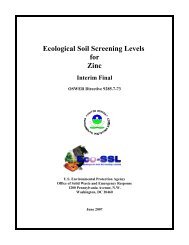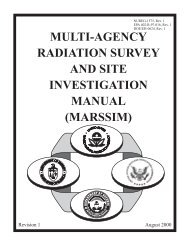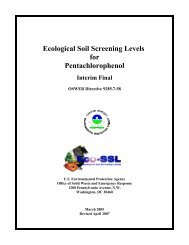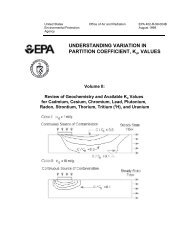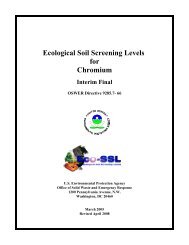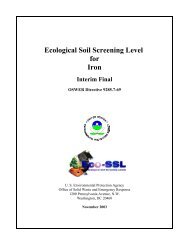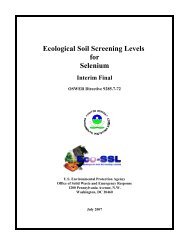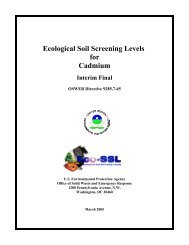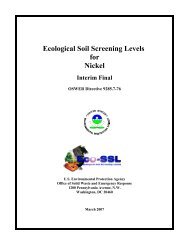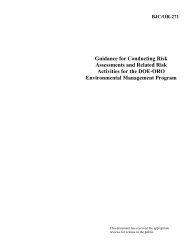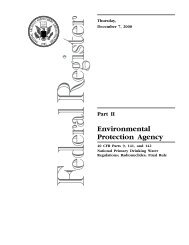Revised Draft Guidance for Performing Screening Level Risk ...
Revised Draft Guidance for Performing Screening Level Risk ...
Revised Draft Guidance for Performing Screening Level Risk ...
You also want an ePaper? Increase the reach of your titles
YUMPU automatically turns print PDFs into web optimized ePapers that Google loves.
HQ '<br />
TABLE C-1-8<br />
HAZARD QUOTIENT: NONCARCINOGENS<br />
(Page 1 of 3)<br />
Description<br />
This equation calculates the hazard quotient <strong>for</strong> indirect exposure to noncarcinogenic COPCs. The following uncertainty is associated with this equation.<br />
A chronic RfD is an estimate of a daily exposure level <strong>for</strong> the human population, including sensitive subpopulations, that is likely to be without an appreciable risk of deleterious effects<br />
during a lifetime. Chronic RfDs are specifically developed to be protective <strong>for</strong> long-term exposure (from 7 years to a lifetime) to a compound. COPC-specific reference doses (RfD) are<br />
unlikely to underestimate a chemical potential <strong>for</strong> causing adverse effects.<br />
Equation<br />
I @ ED @ EF<br />
RfD @ AT @ 365<br />
Variable Description Units Value<br />
HQ Hazard quotient unitless<br />
I Daily intake of COPC i from animal mg COPC/ Varies<br />
i<br />
tissue j kg-day This variable is COPC- and site-specific, and is calculated by using the equation in Table C-1-6. The value <strong>for</strong> this variable<br />
will vary <strong>for</strong> each exposure pathway and each exposure scenario location. Uncertainties associated with this variable are sitespecific.<br />
ED Exposure duration yr 6, 30, or 40<br />
Consistent with U.S. EPA (1994b) and NC DEHNR (1997), U.S. EPA OSW recommends the use of the following default<br />
values.<br />
Exposure Scenario ED<br />
Subsistence Farmer 40 (U.S. EPA 1994a)<br />
Subsistence Farmer Child 6 (U.S. EPA 1989)<br />
Subsistence Fisher 30 (U.S. EPA 1994a)<br />
Subsistence Fisher Child 6 (U.S. EPA 1989)<br />
Adult Resident 30 (U.S. EPA 1989)<br />
Child Resident 6 (U.S. EPA 1989)<br />
Uncertainty associated with this variable includes:<br />
These exposure durations are single values that represent the highest exposure that is reasonably expected to occur at a<br />
site. These values may overestimate ED <strong>for</strong> some individuals.
TABLE C-1-8<br />
HAZARD QUOTIENT: NONCARCINOGENS<br />
(Page 2 of 3)<br />
Variable Description Units Value<br />
EF Exposure frequency days/yr 350<br />
This variable is site-specific. U.S. EPA OSW recommends the use of this default value in the absence of site-specific data.<br />
This value is based on U.S. EPA (1991) and is consistent with U.S. EPA (1994b).<br />
Uncertainty associated with this variable includes:<br />
This exposure frequency is a single value that represents the most frequent exposure that is reasonably expected to occur<br />
at a site with two weeks of vacation or travel. This recommended value may overestimate EF <strong>for</strong> individuals who are<br />
away from their home <strong>for</strong> more than two weeks each year. On the other had, some individuals such as subsistence<br />
farmers, may remain at their home (or farm) <strong>for</strong> more than 350 days per year. In either case, the degree of over- or<br />
underestimation is not expected to be significant in most cases.<br />
RfD Reference Dose mg/kg-day Varies<br />
This variable is COPC-specific, and should be determined from the COPC tables in Appendix A-3.<br />
365 Units conversion factor day/yr<br />
The following uncertainty is associated with this variable:<br />
A chronic RfD is an estimate of a daily exposure level <strong>for</strong> the human population, including sensitive subpopulations,<br />
that is likely to be without an appreciable risk of deleterious effects during a lifetime. Chronic RfDs are specifically<br />
developed to be protective <strong>for</strong> long-term exposure (from 7 years to a lifetime) to a compound. COPC-specific RfDs are<br />
unlikely to underestimate a COPC’s potential <strong>for</strong> causing adverse health effects.<br />
AT Averaging time yr 6, 30, or 40<br />
This variable is site-specific and related to ED. Specifically, the AT <strong>for</strong> noncarcinogens is numerically the same as ED. This<br />
default value is consistent with U.S. EPA (1989), U.S. EPA (1991), and U.S. EPA (1994a).<br />
Uncertainty associated with this variable includes:<br />
The recommendation <strong>for</strong> averaging time may not accurately represent site-specific time; specifically this single value<br />
may under- or overestimate the length of an average adult lifetime.
TABLE C-1-8<br />
HAZARD QUOTIENT: NONCARCINOGENS<br />
(Page 3 of 3)<br />
REFERENCES AND DISCUSSION<br />
NC DEHNR (1997). <strong>Draft</strong> North Carolina Protocol <strong>for</strong> Per<strong>for</strong>ming Indirect Exposure <strong>Risk</strong> Assessments <strong>for</strong> Hazardous Waste Exposure <strong>Risk</strong> Assessments <strong>for</strong> Hazardous Waste Combustion<br />
Units. January.<br />
U.S. EPA. 1989. <strong>Risk</strong> Assessment <strong>Guidance</strong> <strong>for</strong> Superfund, Volume I, Human Health Evaluation Manual (Part A).<br />
Interim Final. Office of Emergency and Remedial Response. EPA/540/1-89/002. December.<br />
This document is cited as the reference source document of the exposure duration <strong>for</strong> adult and child residents. U.S. EPA OSW assumes that the recommended exposure duration <strong>for</strong> the child<br />
resident may also reasonably be applied to the subsistence farmer child and to the subsistence fisher child.<br />
U.S. EPA. 1991. Human Health Evaluation Manual, Supplemental <strong>Guidance</strong>: Standard Default Exposure Factors. Office of Solid Waste and Emergency Response. OSWER Directive 9285.6-03.<br />
Washington, D.C.<br />
This document is cited as a source document <strong>for</strong> exposure frequency and averaging time.<br />
U.S. EPA. 1994a. Estimating Exposure to Dioxin-like Components - Volume III: Site-Specific Assessment Procedure. Review <strong>Draft</strong>. Office of Research and Development. Washington D.C.<br />
EPA/600/6-88/005Cc. June.<br />
This document is cited by U.S. EPA (1994b) as the same document <strong>for</strong> the recommended default exposure duration (ED) values <strong>for</strong> the subsistence farmer and subsistence fisher. The ED value<br />
of 40 years recommended <strong>for</strong> both the subsistence farmer and the subsistence fisher is based on the assumption that “farmers live in one location longer than the general population”.<br />
U.S. EPA. 1994b. <strong>Revised</strong> <strong>Draft</strong> <strong>Guidance</strong> <strong>for</strong> Per<strong>for</strong>ming <strong>Screening</strong> <strong>Level</strong> <strong>Risk</strong> Analyses at Combustion Facilities Burning Hazardous Wastes. Attachment C, <strong>Draft</strong> Exposure Assessment <strong>Guidance</strong><br />
<strong>for</strong> RCRA Hazardous Waste Combustion Facilities. Office of Emergency and Remedial Response. Office of Solid Waste. December 14.<br />
This document recommends the following:<br />
C An exposure frequency of 350 days per year<br />
C Recepter-specific exposure duration values as presented in U.S. EPA (1994a)—subsistence fisher (40 years) and subsistence farmer (40 years) and U.S. EPA (1989)—adult<br />
resident (30 years) and child resident (6 years)<br />
C Adult and child body weights of 70 kg and 15 kg, respectively



